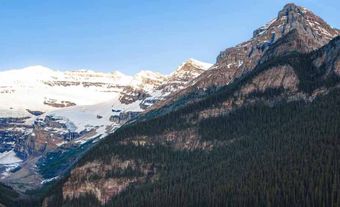Canada was founded along the many waterways utilized by Indigenous peoples, early explorers, fur traders and pioneers. As Canada became a more developed nation, the automobile and roads began to dominate the landscape. Trails were almost forgotten, except in parks and other protected areas. Today, however, Canadians are using trails in increasing numbers. Trails are either managed by organizations such as parks, municipalities and First Nations, or unmanaged. As of 2010, there were 278,576 km of managed trails in Canada. This distance is roughly the equivalent of traversing the country, from Cape Spear, Newfoundland and Labrador, to the Yukon-Alaska border, 50 times. The province with the largest managed trail network is Quebec. Just over 27 per cent of all managed Canadian trails (77,030 km) are found there.

The Bruce Trail, near Limehouse, Ontario. The Bruce Trail is a footpath connecting Queenston, near Niagara Falls, with Tobermory on the Bruce Peninsula.
("Bruce Trail, Limehouse" by claudiu_dobre is licensed under CC BY-NC-SA 2.0.)Types of Trails
Trails take many different forms, from surfaced footpaths through the wilderness, like the Great Divide Trail in Alberta, to paved urban trails or bikeways. Trails can encompass a single path or route such as the Gold Rush Trail in British Columbia, or represent a network of linkages. For example, in the 100 Mile House-Williams Lake region of BC there is a trail system totalling 200 km.
Trail Development
Many early trails were developed through the work of volunteer trail organizations, such as the Bruce Trail Association in Ontario. As interest grows for the development of more trails, different types of groups representing specific trail use, such as snowmobiling, hiking and cross country skiing are becoming more active. In addition, many communities are acquiring trail access along abandoned rail lines. “Rails to Trails” is becoming a popular movement across Canada. The movement follows the example of the Rails-to-Trails Conservancy based in Washington, DC. The Rails-to-Trails Conservancy has been developing trails over abandoned rail lines for several decades.
Trails are popular tourist attractions. They generate economic benefits for the communities and regions which encourage their development and upkeep. Trails are also the catalyst for improving deteriorated urban lands and river corridors. Many groups, service clubs and dedicated individuals are taking charge of their development. In addition, many communities across Canada are developing trails for commuters travelling to and from work by bicycle.

 Share on Facebook
Share on Facebook Share on X
Share on X Share by Email
Share by Email Share on Google Classroom
Share on Google Classroom



